
In November 1965, a reader named Carla sent a letter to “Beat” magazine asking the following: “Can you please tell me who plays background on the Sonny and Cher records; The music is great.” This was the answer she received: “Dear Carla, The people who play the background are session people. Professionals who just work on certain records.”
Session people…an interesting phrase, but I’m guessing that was not quite what Carla was hoping to read. I hope this article helps answer Carla’s question in more detail, if she happens to find and read it, some 41 years later.
For every piece of modern popular musical history literally at our fingertips which we are able to enjoy, preserve, and pass on to future generations, there is obviously so much which has not been recorded nor documented, and has been thought lost to time. Yet in many cases the simplest, random acts of taking a photograph at a recording session, choosing a more stable medium on which to record a rough mix or a demo, or just telling the story-behind-the-story could have ensured that those same future generations would be able to access that information for their own enjoyment and preservation. That aspect alone is what makes a discovery or a rediscovery of something like a photograph, recording, or even an old reel of rough mixes from a classic song such an exciting opportunity for those interested in that part of modern music history. It is like breathing new life into a subject which may not have been considered for years.
With that spirit, we offer our first article for “Classic Studio Sessions”, a discussion and analysis of film footage shot in early 1966 during a Sonny and Cher recording session at the legendary Gold Star studios in Los Angeles. First, however, a bit of the story-behind-the-story is in order.
The origins of this project happened several years ago during separate discussions Josh and I had about recording sessions for “Wouldn’t It Be Nice” by The Beach Boys. Having collected nearly everything official and unofficial around the recording sessions for that song, and after gathering as much information about the recording of that song as probably existed at that time, specifically equipment and personnel details, we wondered if any photo, film, or other visual documentation existed of the actual studio session at Gold Star, which would show exactly how what we were hearing was put together in the studio. Our searches found nothing new. The rediscovery of these images from early 1966, shot within weeks of the Wouldn’t It Be Nice session at Gold Star based on all the evidence I could find, can shed some new light on what *could* have been the setup and layout in that room, and shows the now-classic and long-gone studio as a living, active room.
The problem in researching these sessions is there was just not that much film taken of those sessions - period - especially in the mid-60’s. For those bands whose image relied on fans thinking the people pictured on the album covers and 45 sleeves were the people playing the instruments on the recordings, it would be earth-shattering and potentially career-shattering news to discover that was not the case. Aside from contract photographers like Guy Webster and Jasper Dailey whose photos were sold to various teen magazines and record company publications, and the occasional article in Look or Life documenting a recording session, there was no sense of urgency behind documenting what was going on outside of those involved in the daily process of making the records, as the medium in general was still regarded as “pop”, a disposable format which delivered music to the kids. The musicians in most cases had to remain anonymous, and did for the most part remain anonymous outside of the music community until recently. Finding a newsreel which captured a session at United, or Gold Star, or Western in the mid 60’s is possible and a precious few do exist and are available, but beyond those who knows what survives and what was lost.
Fortunately for us in this case of Sonny and Cher at Gold Star, there was a fledgling newsreel-based syndicated program called “Hollywood Backstage” whose staff was carrying mobile cameras and film crews around Los Angeles documenting the happenings, premieres, and Hollywood glitz, then editing them into primitive but neat vignettes (some with sound, some silent with voiceover narration) which were finally syndicated and sold to television stations around the country. This was the nascent “Entertainment Tonight”, a primitive “Extra”, and an early “Insider” all in one, much like Scopitones of this era was a primitive version of MTV. The stars of the show were the film clips themselves, which could be an on-location interview, a walking tour, footage of a movie premiere, or anything related to Hollywood happenings. Someone decided to film Sonny and Cher recording at Gold Star, as they were considered “hot” at that time and would make several more appearances on the show…unfortunately, for us, the footage of the studio session is silent while other clips from the same show have full audio. I’m not complaining, just commenting…and nearly every piece of footage I’ve been able to see from that series is fascinating, if only to get a look at what Los Angeles pop culture looked like in living color during the mid 60’s.
To put the approximate timing of this film into even more historical perspective, consider just *how* hot Sonny and Cher were as an entertainment entity at that time. Consider the time from late 1965 going into March and April of 1966, when the album they were supposedly working on in the film was released. By January of 1966, they were just finishing up a tour (which also included a lawsuit from Gene Pitney claming they missed earlier dates as his opening act after they became big stars…), and were working on two albums: One became a Cher solo project eventually named “The Sonny Side of Cher”, produced as always by Sonny, and the other became “The Wondrous World of Sonny and Cher”. They were basically playing two roles in their musical lives at that time, both as duo and a solo act, and releasing what today would be a staggering amount of material in that time frame under both labels. Along with that, Hollywood was calling with requests for a motion picture, and on March 14 1966, Sonny and Cher began filming a movie with future Oscar-winning director William Friedkin which became “Good Times”, and which Sonny also co-produced and wrote much of the film’s score and some of the dialogue. On top of all of that, the duo was asked to design an original line of clothing, which they did, based on their own unique and at that time controversial casual style. And the Vice President’s office asked them to work on a short film encouraging kids to stay in school! In the middle of everything, in March 1966, Cher also came down with a bad case of what was called a form of the Asian Flu, which had been hitting some Hollywood circles and put her out of commission for a time during all of this chaos.
The voiceover mentions that the duo were being filmed working on the album “The Wondrous World of Sonny and Cher”, which was released in April of 1966, to be followed soon after by Cher’s solo album. Coincidentally, tough as it is to track down television listings for syndicated shows like “Hollywood Backstage” since every regional market stuck those shows in a different time slot and usually not consistently, there is a listing for an April 29, 1966 broadcast of “Backstage” featuring Sonny and Cher, Lorne Greene, Herb Alpert, and Nancy Wilson. I’m betting this was the original approximate airdate for the syndicated show, and it would match up nicely for promoting a Sonny and Cher album which had just been released that same month. The sessions for the albums were being held in early 1966 and continued into March, so at any time during those three months of off-and-on sessions, the film crew could have shot the footage at Gold Star. The exact timeline, unfortunately, is more speculation than fact until more detailed info is found. And perhaps the session itself was for a solo Cher session rather than Sonny and Cher…again, without exact information we can only assume for now.
Onto the scenes in the film…This is indeed the classic Gold Star studio, the Robin’s Egg Blue painted room where all the magic happened and all those incredible and groundbreaking sounds were captured for posterity. Strip away everything else, and it was a 35x28x12 room where musicians recorded songs…but actually seeing those musicians, in color, working that magic in that specific room can be overwhelming to those who love that music, also adding a new visual element to the music, a visual that perhaps only existed in the mind of a fan as they were listening for the 1,000th time to a record which had been cut there. Watching these musicians at work, seeing the instruments and the vintage equipment and the various inner workings of what many consider a mystical process being done in a magical room with an amazing group of people…it is breathtaking, and refreshing at the same time.
As much as producers and engineers were willing to experiment with studio layouts and how instruments were placed and mic’ed, there was also a certain consistency in how they set up their sessions. If they got a sound from a certain setup which yielded an international hit, they’d naturally try to stay close to that setup for the artist’s next project. My thought on this setup is how close this arrangement probably was to Sonny Bono’s and Stan Ross’s “regular” layout for Sonny’s sessions, and how something close to this is how the studio may have looked for a record like “I Got You Babe”, recorded in the same room with many of the same musicians. Not knowing exactly what song is being worked on in the film clip or even what album they were working on despite what the voiceover says, again it is an educated guess rather than a documented fact.
The issue of the validity of these scenes captured in the film has been raised, with a suggestion that it was perhaps staged for the cameras and the layout would not be seen on an actual session. I agree with the staging to a point, because obviously having the stars Sonny and Cher in the middle of the room singing into an open RCA 44 creates a much better visual for the average fan rather than showing them in an iso booth or inside an empty room cutting vocals after the musicians had gone home. Likewise, the unidentified person sitting behind the drums is joking around and gesturing with his arms rather than actually playing the kit (According to Don Peake: ‘It definitely isn’t Hal!’). And Cher would probably not have gone over a harpsichord part with Mike Rubini, as she was not the arranger or producer - they were acting for the camera and playing for laughs. But, that room and those musicians are set up for a real session, there is no doubt. And whether this film was taken before or after or during the actual session, those musicians would not have been set up in the studio like that only to film a short vignette for a newsreel crew, with baffles/gobos and the various mics around them.
This is a diagram of the layout seen in the film. I’ve tried to show the approximate placement of each musician as well as the baffles used to isolate various instruments as shown in the clip. Equipment identifications are noted wherever microphones and instruments were visible in the shot; Some are educated guesses based on previous interviews and articles describing what was used at that same time at Gold Star. In the case of items like the Shure 55 mic’ing Cliff Hils’ upright bass, it is an odd choice for that instrument and in this case a guess based on a poorly-lit camera angle showing what looks like a 55 placed at knee-level outside the f-hole on the bass, but Josh has suggested it probably is a Shure 55, since a more detailed photo of bassist Jimmy Bond playing a Spector session shows a similar setup at Gold Star with the 55. Likewise, Josh thinks the overhead shown above the drums could be a Sennheiser 421 rather than a U67, again due to the film quality it is very difficult to see. If anyone can see these details better, or knows the facts and wants to take a guess, please add your opinions! (Note: Click on any image to enlarge)
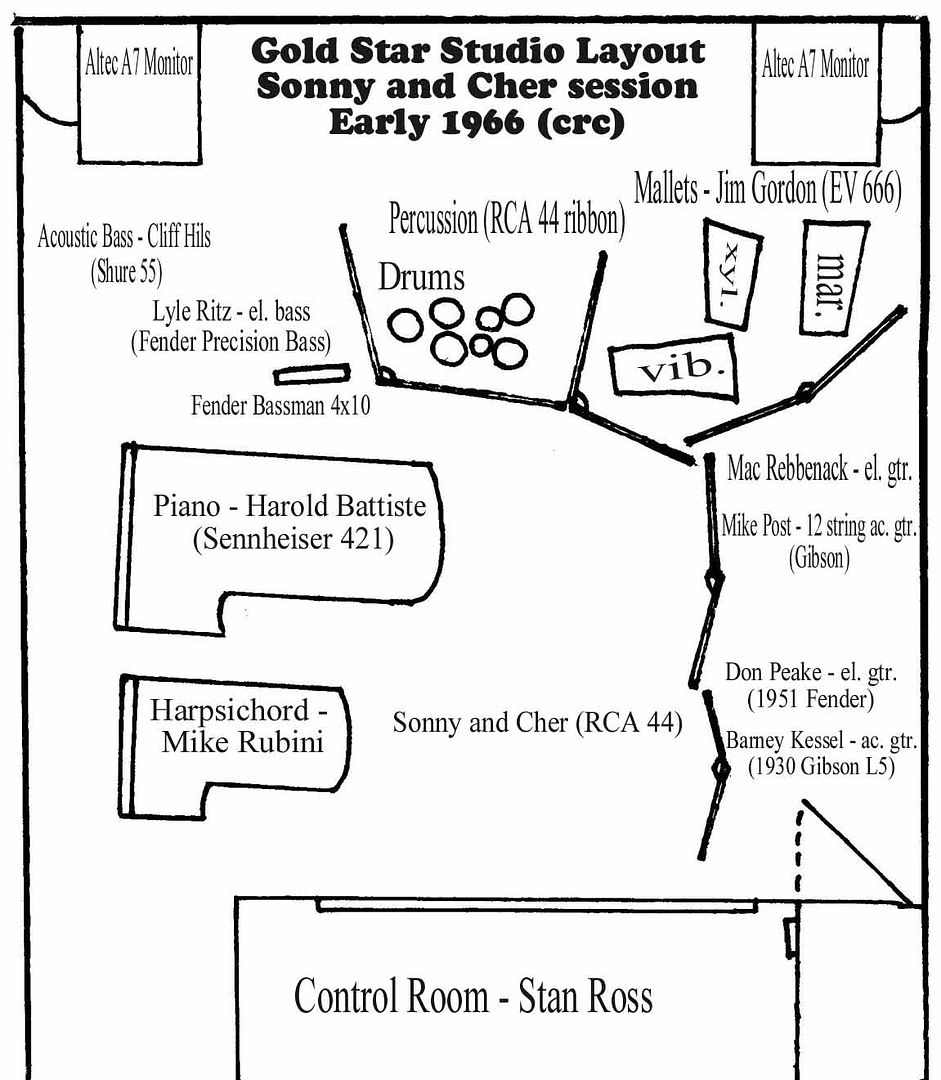
It is interesting to compare and contrast this layout with still photos of various other sessions in this same room, like those showing Phil Spector’s “Christmas Gift For You” sessions and others he cut in this, his favorite room. Sonny and Stan have a U-shaped layout with space in the middle, where Phil and Larry Levine in several photos had the drums in that center space, guitars back left (from the booth), horns back right in front of the Altec A7, bassists front right, and pianos and keyboards against the glass directly outside the booth. Again, each engineer and producer had their own formula and would change the setup plans, but would still remain somewhat consistent. In nearly every photo, the one constant has been the grouping of instrumental sections, and how the guitars were sitting together with other guitars, bassists together, keyboards together, drums and percussion together, etc. Remember too that this room was literally an empty room when the first people walked in to set up a session, and that setup could change up to 5 times each day depending on the schedule. The placement of the musicians is usually given less weight then the gear in the “how did they get those sounds!” discussions, but that setup and the way the instruments reacted to the room’s acoustics was perhaps as crucial for the sound of any given record as the type of mic they were using. This aspect of the process can also be one of the true “lost art” elements of the way those records sound, since recording 4 guitars, 2 basses, and three keyboards playing live in the same room very soon became outdated as more tracks were available to use.
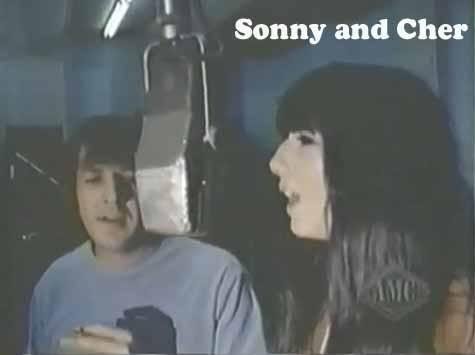
The musicians pictured in the film were and are among the best in Los Angeles, and some faces which would later become familiar outside of the session scene were present. Most notable and/or surprising has to be Mac Rebbenack, better known as Dr. John, seen here playing guitar where he’d more often be seen at a keyboard. One of the backstories I’ve heard is that Dr. John was in Los Angeles by way of Harold Battiste, pianist and arranger who can briefly be seen at the piano behind Cher in one very quick camera edit…and who worked often with Sonny and Cher at this time. The story is that Harold helped introduce Mac to Los Angeles around 1965 after Mac had some troubles in New Orleans, worked him into the session scene, and then “borrowing” extra studio time from Sonny Bono’s session bookings, Battiste and Rebbenack began recording tracks which would create the “Dr. John” persona, bringing the grooves they knew and played in New Orleans to a wider audience on Dr. John’s “Gris Gris” album. In this case, it is interesting to see Mac and Harold on the same date, specifically with Mac playing guitar when most people associate him with the piano.
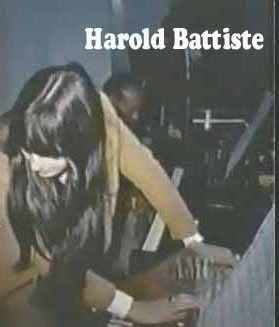
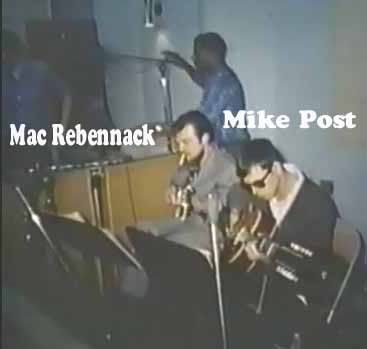
Naturally there are websites with much more background information about these musicians than can be listed here, and I would suggest doing a simple web search for some of these names to get more information on them, especially those who are not as well known to the general public. The great thing about a film like this is putting an image to a name and having that image come from a time when these players were involved with what we would call “classic” recording sessions. There is no substitute for seeing everything set up exactly as it was and seeing these people playing the same instruments through the same gear as we hear on so many classic records, putting a face to a name to the sounds. It is unfortunate that until projects like “The Pet Sounds Sessions”, “The Funk Brothers” documentary, and projects like “The Wrecking Crew” documentary, these names existed without a face to connect the actual musician to many in the general listening audience who loved the records but had no idea who was playing on them.
A big mystery of the film remains unsolved: Who was the drummer, and why wasn’t he on camera? The man joking behind the kit also remains unidentified as of this time, and we can only guess by the album credits that the drummer on this date could have been Hal Blaine, Earl Palmer, or Frank Capp, who are listed as playing on Sonny’s sessions at this time. Unfortunately the baffle on the studio floor blocks the drum kit, so we can’t ID whose kit it was by make or model, and we still don’t have a firm session date for this film to match names on the contract with the date of the film. It could be any of those three drummers or even someone not credited elsewhere, and why he wasn’t there to be filmed will remain a mystery as well. The percussionist who was positioned next to the drum kit is also unidentified because there are just no clear shots of his face - the only thing you can see in the film is that they were using an RCA 44 to capture whatever he was playing. Could it be Gene Estes, Emil Richards, or someone at the studio that day who was enlisted to play tambourine or maracas as Sonny had done at Phil’s sessions? It’s anyone’s guess until a positive ID is made. It is also interesting to see a young Jim Gordon at work on the mallets during this date, well before his most visible drum work with Clapton, and here at the early part of his run as an influential session drummer. Like Dr. John and the piano, we associate Jim more with the drums than percussion/mallets and seeing him playing the vibes here is an interesting change. Perhaps he was the mystery drummer???

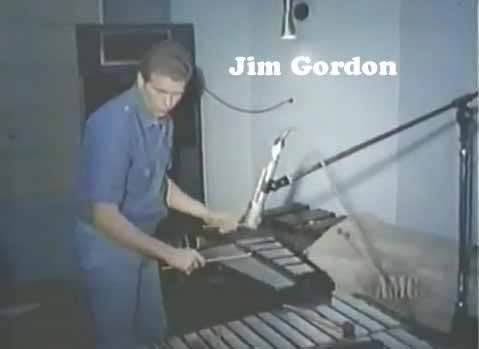
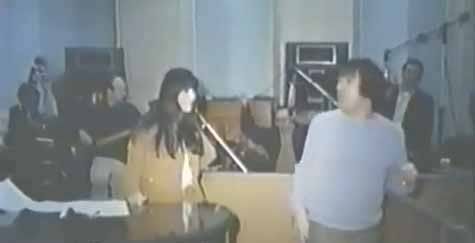
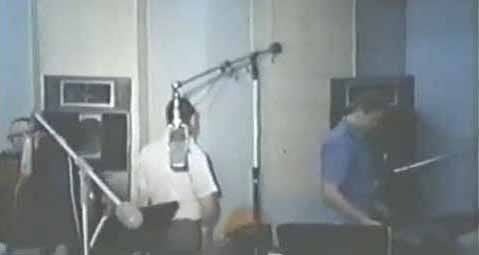
The guitars show a relatively standard setup for the kind of multiple guitar arrangements producers like Spector, Bono, Wilson, etc. were using on sessions at that time. The only one missing from the usual lineup here would be the Danelectro bass, for the muted “tic-tac” doubling of the bassline. Maybe that was what Dr. John was doing here, since we really cannot see what he is playing, although the shape of his guitar could be that of a Rickenbacker 360/12 12-string, another instrument and sound very popular at this time.
Don Peake was lead guitarist, and is shown playing his modified 1951 Fender, a now highly-collectible guitar which he had converted into a Telecaster by adding the neck pickup! You can see Don playing this same awesome Fender model on several film clips and photos from this era, including a live film of a Jan and Dean concert and earlier footage of when Don was touring with the Everly Brothers in the early 60’s (along with Jim Gordon). You cannot see an amp in the shot, but I’m guessing it was something like a Fender Deluxe, 4x10 Bassman, or brown Vibroverb, those standard models which are pictured in nearly every mid 60’s studio session around LA. Barney Kessel is shown on this date playing acoustic rhythm on an arch top, a role which both he and Tommy Tedesco were apparently doing often on sessions at this time. The guitar Barney is playing and in one scene hiding behind has a fascinating history, and was actually owned by Don Peake! According to Don, that was a 1930 Gibson L-5 which he had acquired from Howard Roberts, and a guitar which can be heard on classic recordings like “America The Beautiful” and “You’ve Lost That Lovin’ Feeling”. Notice a young Mike Post - The same Mike Post who would later win Grammy and Emmy awards, at age 23 arrange the Mason Williams classic “Classical Gas” featuring Jim Gordon on drums, and most famously compose familiar award-winning themes for film and television like “Hill Street Blues” and “The A-Team” among others - wearing his shades and playing a folk-approved Gibson 12-string acoustic guitar with capo.
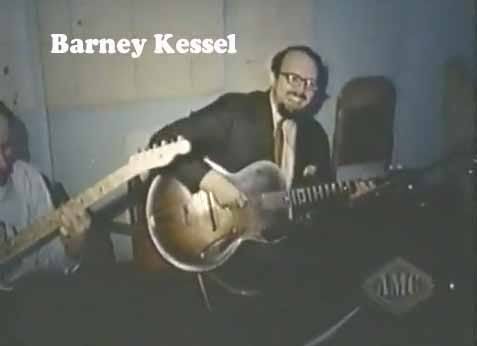
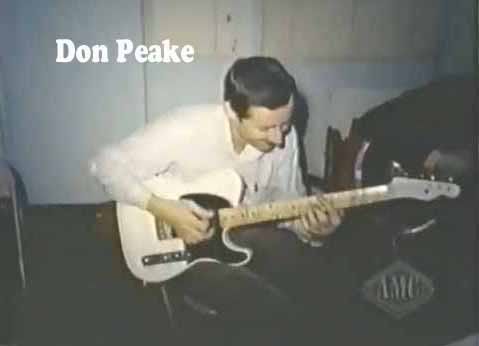
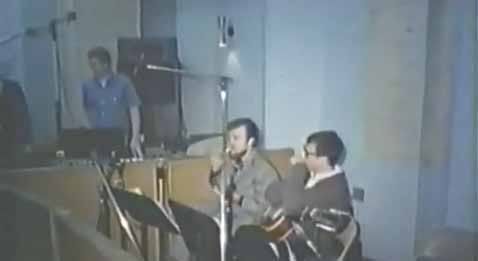
The bassists were off to the left of the room, and again as was standard for sessions, there were both upright and electric basses playing the parts. It is interesting for me as someone who is most familiar with Brian Wilson’s sessions of this time to see Lyle Ritz playing a Fender Precision electric, since Brian always had Lyle playing his upright bass parts while Carol Kaye or Ray Pohlman played the P-Bass. Lyle played some of Brian’s most famous acoustic basslines like “Good Vibrations” and some amazing parts in “Heroes And Villains” including some bowed sections which got mixed out or cut out of the final mixes. Seeing him play Fender bass through the classic 4x10 Bassman amp here is neat, next to Cliff Hils on upright, and surprisingly it is the second session for Sonny Bono where I‘ve seen Lyle photographed playing that bass. The mystery here remains the microphone on Cliff’s bass, as mentioned earlier. If that is a Shure 55, why use that dynamic mic, most often associated with live vocals and PA systems, on acoustic bass? Or is it a ribbon mic of some kind, like an Altec? It’s too dark and grainy on the film to see.

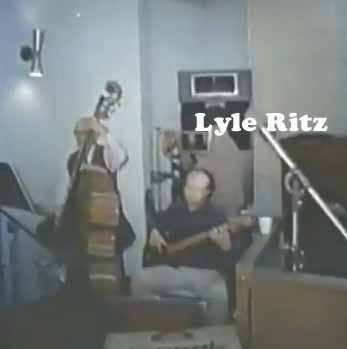
On keyboards, Michel “Mike” Rubini is playing harpsichord and Harold Battiste, who also served as Sonny’s arranger for various sessions, is on piano. This is a scaled-down version of what Spector and Wilson were doing with layering sometimes 4 or 5 different keyboards and pianos on a live session date, instruments which could include on any given session piano, upright (usually tack) piano (one which can be seen covered up in the back of the room in the film, against the wall between the Altec monitors), some kind of Hammond organ, electric piano, harpsichord or celeste, etc., all of them playing together in the same room. It is easy to forget the need for live musicians and live instruments like those multiple keyboards when sampling and instrument modeling has been the standard for several decades.

The shots of the control room are awesome, however I wish less time were spent showing the Ampex tape machine and more time was allowed for various close-ups on the people and the equipment in that booth! Beyond the obvious, notice there is a shadowy figure standing behind Sonny and Stan Ross at the board - He has been identified as Phil Spector, decked out in shades, cap, and overcoat! Dropped in for a visit, I guess… Also notice those shots of the Ampex tape machine: The thought is that this machine (rather than being the recorder as suggested in the narration) was actually serving as the tape delay. The Gold Star method from Phil Spector’s “Wall Of Sound” with Larry Levine was to send the live sound from the board through the tape delay, *then* into the chamber, then mixing it together with the live sound on the way back, which was the reverse of how most would be doing it and one of the keys to that whole huge, pulsing sound which on certain tracks sounds like it could explode into feedback at any moment. Interesting, if that machine was the one responsible…in conjunction with those echo chambers, of course.
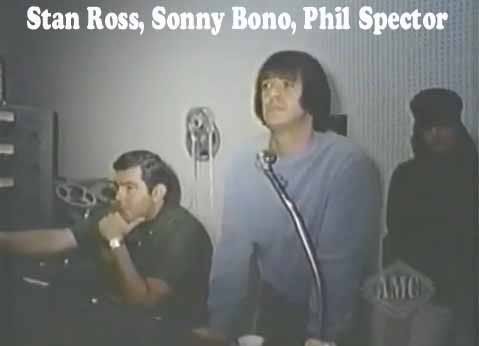

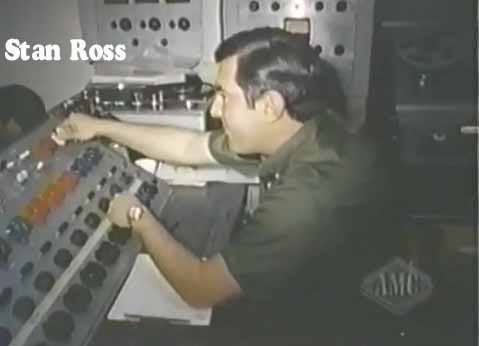

I love seeing the color shots of the board. Obviously Stan Ross isn’t actually running anything as he’s filmed with his hands on some random control, but aside from the famous shots of Spector at or near that board usually in black and white, seeing it in full color with the multi-colored knobs and the groovy 60’s Woodgrain paneling detail is cool. I always like seeing those rotary knob boards like the modular boards at United/Western with the 610’s and a few switches, and whatever Wally Heider built from those for his famous live board. There is something very “natural” about the signals going into and through those boards, and something organic which perhaps in my own mind contributed a lot to the pure sounds of those records. I still think the guitar and bass recordings on those mid-60’s sessions from Gold Star and Western rank among the best and most true recordings of those instruments as have ever been done. Try to search out any session tracks from Gold Star where you can hear them raw, before they were mixed down and mastered for singles and AM radio play, and you’ll be amazed at some of the sounds, especially the clarity of the guitars.
Other mysteries of the film are the folks in the control room, among them a man seated in the waiting area in front of the board, and a blond woman sitting next to Cher reading a magazine.

Were these friends, assistants, managers, etc.? Anyone’s guess…Also, notice the staff member in the blue shirt setting up microphones and adjusting stands on the studio floor. He is in several shots, and seems to be doing the same studio assistant job as Winston Wong was doing at Western in similar period photos. Anyone know this man’s name, or whether he appears in any credits?
Finally, a look at the microphones and monitors. The usual models and placements seem to be shown, specifically the EV 666 on the vibes, a choice which can be seen in other mid-60’s Gold Star sessions where vibes were being recorded. Obvious use of the RCA 44 for vocals, and although the shot was clearly staged for the film, that would have been the main choice I’m sure for vocals, along with the RCA 77 ribbon. The RCA 44 is also being used on percussion, which I found interesting…and not as surprising they have what looks like a U67 as an overhead above the drum kit. Unfortunately there are no clear shots of the other mics or what they were using on various instruments. We can only guess from other sources and interviews that Shure and EV dynamics were used quite often for guitars and amps, as well as mics like the Sennheiser 421 on piano and perhaps Sony C37’s somewhere a large condenser was needed. The ubiquitous Altec “Voice Of The Theater” A7 monitors are visible in their usual position, as they are in nearly every photo of Gold Star in the mid 60’s.
We have heard the records for decades: Now we can see who was creating those incredible sounds, in their working environment, and associate a face with a name we’ve perhaps only read in reissue liner notes and various rock history books. As a piece of film which I once had in my collection but lost over the years in an out-of-control stack of unlabeled VHS tapes, I was thrilled to see it reappear and even more thrilled to be able to answer some of the questions and use the resources we have available to gain even further insight into what was going on that day inside Gold Star. Oh, to have been there for one of those dates…film like this may be the closest we’ll get visually to the experience of a session.
And for that fanzine reader named Clara who wrote the letter wanting to know who played on Sonny and Cher records 41 years ago, I hope we helped answer your question.
-Craig R. Clemens, 2010
Bonus Photo:
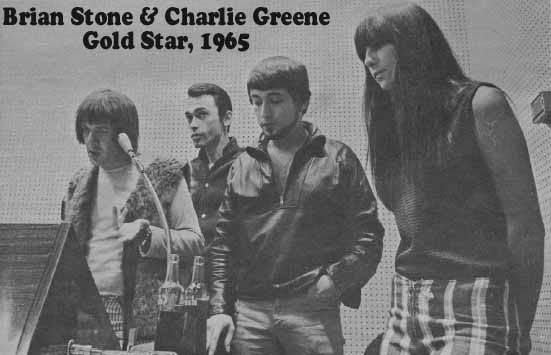
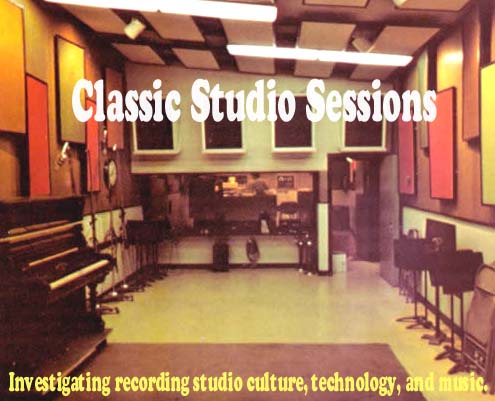
5 comments:
Craig this is awesome: I'll definitely be linking from www.sonnycher.com in the very near future. Your research is impeccable.
Rick
Guitarfool,
I am a banned member of Smiley Smile so I cannot PM you. I read your post about a "Penny Lane" outtake which has a Smile feel to it.
I am a firm believer in the "Beatles heard Smile" despite AGD's supposed evidence to the contrary. History in its dry numbers in a book form is not always accurate and can be changed. I smell conspiracy. I don't think the Beatles traveled to the U.S just to hear it, but I suspect Derek Taylor brought them some of Brian's new music. It is just quite obvious when you consider that both bands were each other's main competitors in many ways, especially artistically. If Paul had been playing Pet Sounds non-stop during the Pepper sessions, does this not suggest that he was trying to "top" it and figure out its secrets?
Imagine the Beatles' shock hearing how fast Brian advanced on Pet Sounds. He suddenly became a songwriting GOD with things like Don't Talk. So, go a step further and imagine the sheer terror Paul (in particular) must have felt in wondering just how far Brian would advance past Pet Sounds for the new record! It must have been ego-shattering to know that this one man mad genius in the States is out-doing him creatively.
Imagine the phone call. Oh hey Derek how you doing, how's Brian Wilson's new music?
Oh Paul... you've gotta hear it, it's weird and wild stuff, man! I'll bring you a tape on Monday...
Etc. It's not that I feel Pepper blatantly ripped off Smile, but there is a certain whimsical quality found also in Smile, a shedding of one's old skin musically, allowing freedom of expression anew. Personally I don't consider Pepper to be on the same level as Smile, artistically. Pepper is basically a collection of Beatles pop songs with interesting production touches brained by Paul & George Martin. Smile is... well, you know. The Smile songs are more abstract and unusual - Cabinessence, Wonderful, etc. If Paul's peak of Pepper balladry is She's Leaving Home, and Brian's is Wonderful (both being played to each other and having similar themes) then to this mind's notice, Brian's song triumphs as a timeless mindbending music box mystery, while Paul's is just a good but not that much out of the box song.
I think the mystery drummer is most likely Frank Capp. Sonny used him frequently. You can PM Hal Blaine on Facebook - I bet he would recognize if it's Capp.
Incredible.
On "The Wrecking Crew" film website, they have links to the session contracts for a several of The Wrecking Crew's hits. This is the one for the "I Got You Babe" session: http://www.wreckingcrewfilm.com/afmcontracts/Sonny+Cher_IGotYouBabe.pdf
It lists the drummer as Frank Capp.
Post a Comment